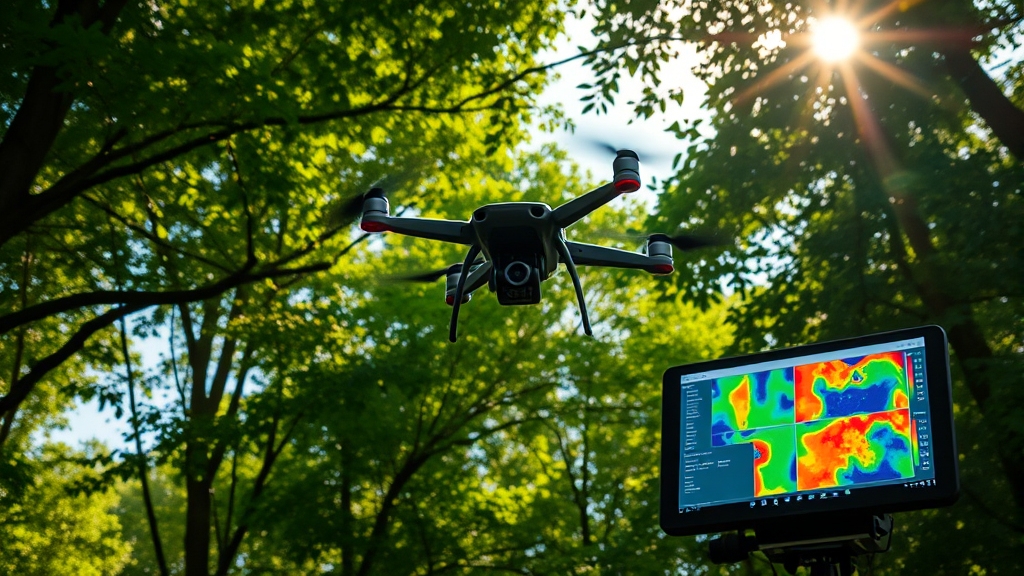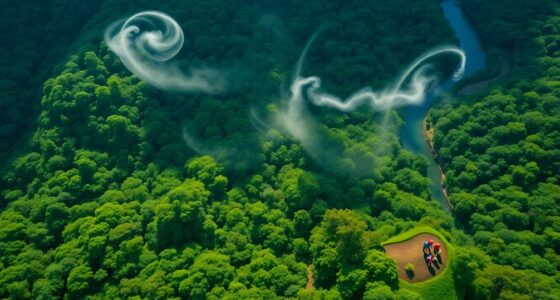Innovative conservation technologies like drones, AI, and satellite imagery are transforming how you protect ecosystems. Drones with advanced sensors monitor wildlife and habitats without disturbance, while AI analyzes data for patterns, helping you target efforts efficiently. Satellite tools identify degraded areas needing attention and support habitat restoration. These innovations promote real-time monitoring and community involvement. Keep exploring to discover more ways these cutting-edge tools are shaping the future of conservation efforts.
Key Takeaways
- Drones equipped with high-resolution cameras and thermal sensors enable non-intrusive, detailed wildlife monitoring and habitat assessment.
- AI algorithms analyze real-time data to detect threats, track individual animals, and optimize conservation strategies.
- Satellite imagery and aerial surveys identify degraded areas, guiding targeted habitat restoration efforts.
- Data integration from multiple sources enhances monitoring accuracy and fosters community participation in conservation.
- Innovative technologies shift conservation from reactive to proactive, supporting sustainable biodiversity preservation at scale.

Have you ever wondered how modern technologies are transforming conservation efforts? Today’s innovations are revolutionizing the way we protect and restore ecosystems, making it easier to track wildlife and rehabilitate habitats. With tools like drones, AI, and satellite imagery, conservationists can gather real-time data that was once impossible to obtain. This shift allows for more targeted, efficient, and effective strategies, guaranteeing that efforts to preserve biodiversity are both smarter and faster.
Wildlife monitoring has seen a dramatic boost thanks to these advancements. Drones, equipped with high-resolution cameras and thermal sensors, fly over vast areas, capturing detailed images of animal populations without disturbing them. This technology enables you to monitor elusive or endangered species more regularly, helping you detect threats like poaching or habitat encroachment early on. AI algorithms analyze the collected data, identifying patterns and tracking individual animals, which facilitates precise population counts and movement patterns. As a result, you gain a clearer understanding of species health and can implement timely interventions to prevent declines. Additionally, these tools promote community engagement, allowing local populations to participate actively in conservation efforts. Incorporating data integration from multiple sources further enhances the accuracy and usefulness of monitoring results. Embracing these technologies also reduces the need for invasive fieldwork, helping to maintain the ecological integrity of sensitive habitats. Moreover, utilizing advanced analytical techniques can improve your ability to interpret complex datasets and optimize conservation strategies. Staying informed about emerging innovations in conservation technology can also give you a competitive edge in protecting biodiversity.
Drones and AI enhance wildlife monitoring, enabling early detection of threats and precise tracking of animal populations.
Habitat restoration also benefits immensely from these cutting-edge tools. Satellite imagery and aerial surveys give you a detailed view of degraded landscapes, pinpointing areas that need immediate attention. Drones can deliver supplies, plant native vegetation, or even remove invasive species, accelerating restoration projects. AI-powered data analysis helps you predict how ecosystems might respond to different interventions, allowing for more strategic planning. By integrating these technologies, you can monitor the progress of habitat restoration efforts continuously, adjusting your tactics as needed to optimize outcomes. The use of remote sensing significantly enhances your ability to make data-driven decisions and prioritize areas for action.
Moreover, these innovations foster collaboration and community involvement. Data collected through remote sensing and AI analysis can be shared with local stakeholders, scientists, and policymakers, encouraging collective action. You can provide real-time updates on wildlife health and habitat conditions, making conservation efforts more transparent and inclusive. These technologies also reduce the need for intrusive fieldwork, minimizing disturbance to wildlife and habitats, which is vital for maintaining ecological integrity.
In essence, modern conservation technologies empower you to be more proactive and precise in your efforts. They enable detailed wildlife monitoring and swift habitat restoration, transforming conservation from reactive to preventative. As you adopt these tools, you contribute to a future where ecosystems are healthier, species are protected, and the natural world can thrive alongside human development. The integration of drones, AI, and satellite data isn’t just about technology; it’s about creating sustainable solutions that guarantee the preservation of our planet’s incredible biodiversity for generations to come.
Frequently Asked Questions
How Do Conservation Drones Impact Local Wildlife Habitats?
You might wonder how conservation drones impact local wildlife habitats. They enhance wildlife monitoring by providing detailed, real-time data, helping you track animal populations without disturbing them. Drones assist in habitat preservation efforts by detecting threats like illegal logging or poaching early. While they offer valuable insights, you should also consider potential disturbances if used improperly. Overall, they support your goal of protecting habitats more effectively and sustainably.
What Are the Privacy Concerns With AI Surveillance in Conservation?
You might worry that AI surveillance in conservation raises data privacy concerns, as sensitive information about local communities and wildlife could be unintentionally exposed or misused. This technology also brings ethical implications, like invading people’s privacy or disrupting habitats without consent. It’s essential to balance conservation goals with respect for privacy rights, ensuring transparent data practices and ethical guidelines to prevent misuse and protect both people and wildlife.
Can These Technologies Be Used Effectively in Developing Countries?
Imagine planting seeds in a garden where every hand counts. You can see these technologies thriving in developing countries if you focus on community engagement and overcome funding challenges. With local buy-in, technology becomes a shared tool for conservation, not just a distant gadget. By rallying support and securing resources, you transform innovation into a collective effort, turning potential into powerful action for preserving nature’s beauty.
How Do Costs Compare Between Traditional and Innovative Conservation Methods?
When comparing costs between traditional and innovative conservation methods, you’ll find a notable difference. A thorough budget analysis shows that innovative tech often requires higher initial investments but can reduce long-term expenses through increased efficiency. Traditional methods may be cheaper upfront but might need ongoing costs for manpower and resources. Ultimately, weighing immediate costs against potential savings helps you make informed decisions for sustainable conservation efforts.
What Are Future Technological Developments Expected in Conservation Efforts?
You’re likely wondering what future conservation tech will look like. Expect advancements like genetic engineering, which can help restore endangered species, and enhanced community engagement platforms that foster local involvement. These innovations will make conservation more precise and inclusive. As you explore these developments, you’ll see how technology becomes a crucial tool, enabling you to protect ecosystems more effectively while empowering communities to participate actively in preserving their environment.
Conclusion
By embracing innovative conservation technologies like drones and AI, you become a crucial force in protecting our planet. These tools are like a lighthouse guiding you through the darkness of environmental challenges, illuminating solutions and empowering action. As you harness these advancements, you help create a future where nature thrives and ecosystems recover. Together, you can turn technological innovation into a powerful catalyst for lasting change, making a difference as profound as the stars guiding a night sky.






